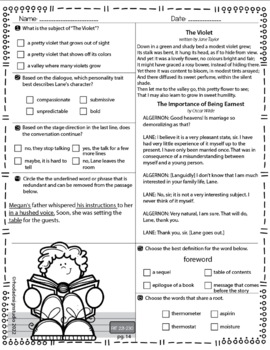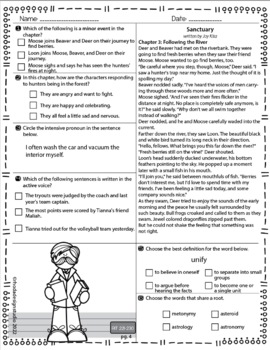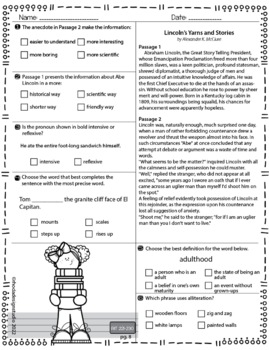SET 1: NWEA MAP Prep ELA Reading Practice Worksheets RIT Band 221-230 Spiral
- PDF
What educators are saying
Also included in
- A new FULL bundle of each set of practice worksheets to help with spiral review and MAPS test prep. Seven sets of RIT Band worksheets.Skills are for the NWEA RIT Bands 161-230.These worksheets can be used for test prep (NWEA MAP, SBACC or any other state testing) or reading interventions or ELA pracPrice $44.10Original Price $49.00Save $4.90
Description
A new set of practice worksheets to help with reading and language arts spiral review and MAPS test prep.
These worksheets can be used for test prep (NWEA MAP, SBACC or any other state testing) or reading interventions or ELA practice. This set of worksheets covers Reading Literature Skills, Reading Informational Text Skills, Vocabulary, and Language and includes skill-level reading comprehension passages.
Skills are for the NWEA RIT Band 221-230 and based on CCSS.
Once your students have taken an ELA placement test, a benchmark test or a standardized testing (SBAC , NWEA Maps, etc.) you can use these reading worksheets to help practice ELA concepts.
Help your students develop their current reading and language skills and introduce them to the next level of Common Core State Standards.
Use these worksheets as bellwork, homework, in conjunction with your current reading curriculum, and as interventions.
Practicing with these reading and language problems will help your students with state standardized testing, provide RTI (response to intervention), and engage them in everyday ELA practice.
You can use these during small math group time, reading centers, and individual practice time.
They can also be used as bell work, daily practice, review, for test prep, independent centers, or to assess skills that your students need to master.
Even if your school doesn't use MAP testing, these worksheets make great review and practice for 3rd, 4th, and 5th grade or remedial practice for 6th grade.
20 worksheets with answer keys (6-7 questions per worksheet).
Thank you for taking the time to check out my store. If you have questions or would like a variation, please email me :)
This product was created based on Common Core standards and is in no way affiliated with the NWEA organization. All content, design, and material (other than clipart from other sellers) is my own original work.
----------This product is a DIGITAL DOWNLOAD.---------
Want to earn free products on TPT and make a teacher-author’s day?
Feedback means a lot to sellers on TPT - we want to hear how useful our products are in your classroom and what needs we can fulfill. Don't forget to leave feedback on items you've purchased - you earn 1 TPT credit for every dollar spent on TPT. These credits can be used to purchase future items. Log in, go to "My Purchases" and click on the "Provide Feedback" link next to each product - it's that easy!






